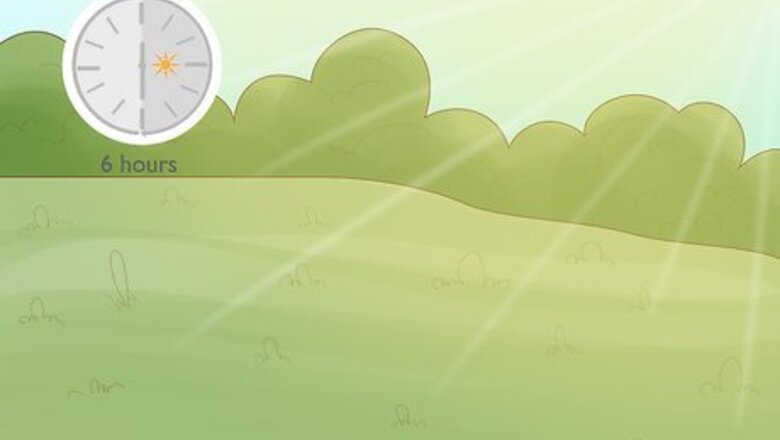
views
X
Research source
To build a simple raised bed, first find a flat, sunny location in your yard. Construct a frame for your bed with durable wood planks and fill it up with vegetables or flowers.
Planning Your Project
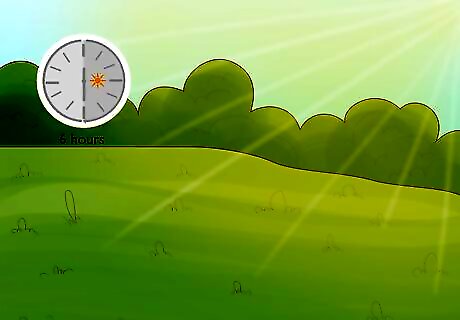
Choose a location for your bed that gets full sun 6-8 hours a day. Most vegetables do best if they get full sun for most of the day. Find a spot where any plants you intend to grow will get all the sunlight they need. If you plan to have several planting beds side-by-side, orient them so the long sides face north-south. This will prevent the beds from shading each other. Avoid building your planting bed under a tree to prevent excessive shade and leaf litter.
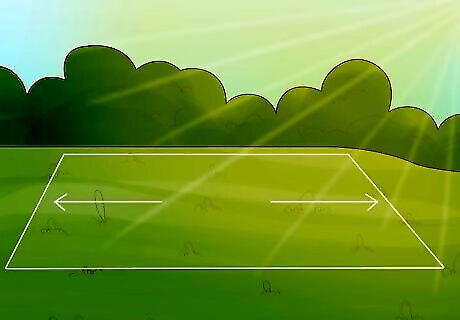
Select a level spot. Find an area in your garden that is as flat as possible. Not only will this make it easier for you to build, but it will also help prevent water from draining unevenly from the planting bed. To check if the ground where you want to build is level, hammer 2 stakes into the ground around the same distance apart as the length of the planter you want to build. Tie a length of string between the stakes and hang a carpenter’s level on it. If the area is level, the bubble should appear between the 2 center lines. If you can’t find a level part of your lawn, you may have to topdress it to even out bumps, or even build a terrace if your whole yard slopes. You can level out uneven areas in your yard by filling in depressions with soil and tamping it down.
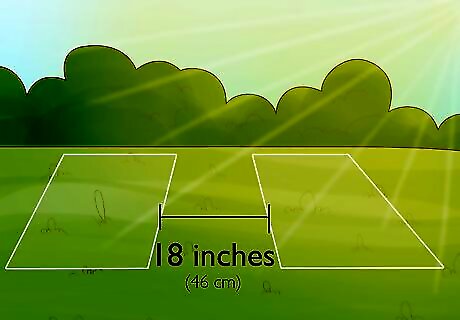
Find an area with room to move around on all sides of the planter. Ideally, you should be able to reach everything in the planting bed without having to step into the bed. Look for a spot in your garden where you’ll have the freedom to move all around the planting bed so you’ll have easy access for watering, weeding, and harvesting. If possible, leave at least 18 inches (46 cm) between the planting bed and any surrounding beds or planters so you can move between them easily. You can build your planting bed up against a wall or fence if you wish, but you’ll need to make it narrow enough so you can easily reach plants at the back of the bed (i.e., at most 2 feet (0.61 m) wide).
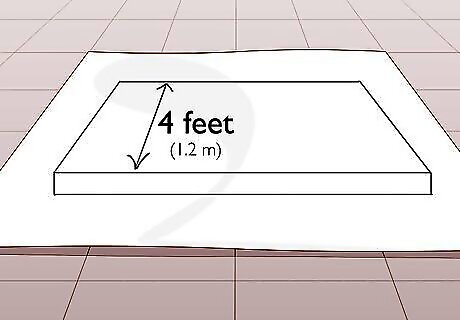
Make your planter no more than 4 feet (1.2 m) wide. You can make your planters as long as you want, but they’ll need to be narrow enough so that you can easily reach all the plants inside. For most people, 4 feet (1.2 m) is the maximum comfortable width. EXPERT TIP Steve Masley Steve Masley Home & Garden Specialist Steve Masley has been designing and maintaining organic vegetable gardens in the San Francisco Bay Area for over 30 years. He is an Organic Gardening Consultant and Founder of Grow-It-Organically, a website that teaches clients and students the ins and outs of organic vegetable gardening. In 2007 and 2008, Steve taught the Local Sustainable Agriculture Field Practicum at Stanford University. Steve Masley Steve Masley Home & Garden Specialist Think about the width of the bed. According to the team at Grow it Organically, raised beds are often designed too wide. "If you make the bed too wide, you'll strain your back trying to reach the middle. Make it just wide enough to do 2 rows on the outside, and maybe a staggered row in the middle, so it will be easier to reach. And if you're putting the bed against a fence or something, it should only be 2 rows deep, so you can reach the back of the bed easily." For example, you might build a planting bed that’s 4 feet (1.2 m) wide and 8 feet (2.4 m) long.
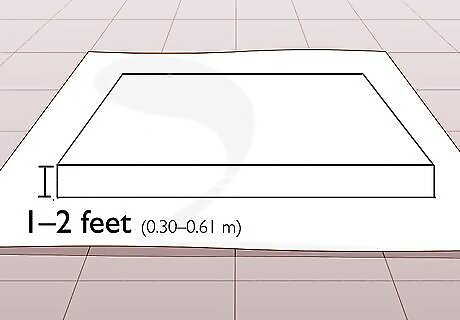
Build your planter at least 6 inches (15 cm) high. The planter needs to be high and deep enough to accommodate the roots of your plants, so 6 inches (15 cm) is the absolute minimum. If possible, build your planter 1–2 feet (0.30–0.61 m) high. A higher planting bed also has the advantage of being easier to reach without bending over or squatting as much.
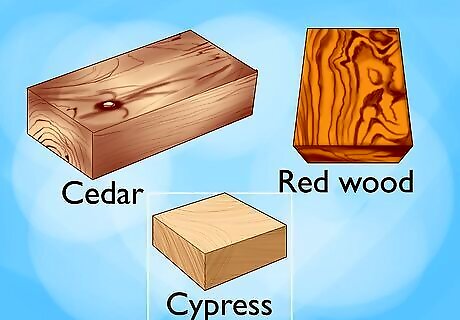
Select a durable type of wood for the frame to prevent rot. Wood is the most common material for building raised planting beds, although you could also use other materials, such as brick, concrete, or even aluminum siding. If you go with wood, select a type that is chemically treated to last longer.Warning: Don’t use railroad ties to make your raised planter. They are often treated with a toxic compound called creosote. Most modern pressure-treated or chemically treated lumbers no longer contain arsenic or other toxic compounds. Choose a copper-based treatment such as ACQ, which is considered safe for food crops. If you’d rather avoid chemically treated wood altogether, get a more durable type of natural wood, such as cedar, redwood, or cypress. These types of lumber are more expensive than less durable woods, like pine, but they may last for up to 20 years.
Constructing the Frame
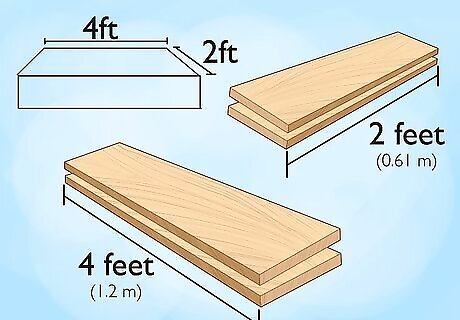
Cut your timbers to the desired length. Once you know the desired dimensions of your raised planting bed, cut 4 planks of wood to the lengths of the sides of your planting bed. Unless you plan to build up the walls with several courses of wood, choose boards that are wide enough to reach the desired height (e.g., 18 inches (46 cm)). For example, if you want to make a planter that’s 2 feet (0.61 m) wide by 4 feet (1.2 m) long, cut 2 planks that are 2 feet (0.61 m) long and 2 planks that are 4 feet (1.2 m) long to make the sides of the frame. You may be able to cut your boards to the desired length at the store where you buy them.
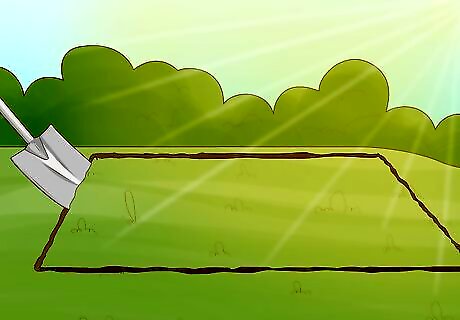
Mark the outlines of the planter where you want to build. After you’ve determined exactly where you want the planter to be, measure out the outline of the bed and mark it out. There are a couple of ways to do this: Use a shovel or spade to cut grooves into the turf along the outer edges of the planting bed site. Alternatively, mark out the corners with stakes and run string or twine between them to define the edges of the bed.
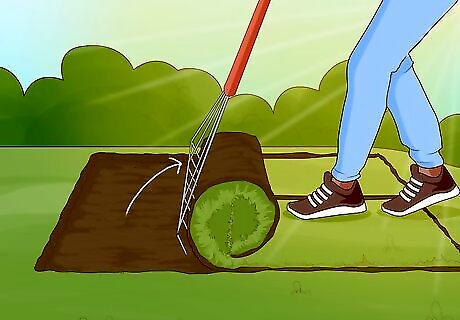
Remove the turf from the area inside the planter. Use a spade to remove all the grass from inside the area you’ve just marked off. Water the area lightly 3 or 4 days ahead of time to soften up the soil. When you’re ready to start, use a sharp spade to score the turf into 1 ft (30 cm) wide parallel strips. Lift an end of each strip with the edge of a spade or garden fork, then roll the strip up and remove the roll from the planting area. Purchase or rent a sod cutter to make this task easier, especially if you’re building a long planting bed. If you come across any large rocks or old roots under the turf, remove those as well. If you remove the turf carefully enough, you may be able to save it and use it to patch another area of your lawn.Tip: If you don’t plan to save the turf, you can make this process easier by killing the grass before you remove it. Cover the area with a tarp or a layer of cardboard for about 6 weeks, then dig up the dead grass.
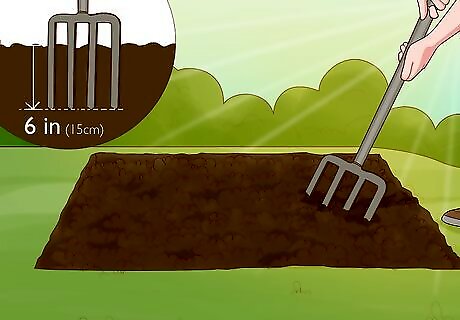
Loosen the soil underneath the removed turf. Take a garden fork and break up the soil inside the outlines of the planter. This will make it less compact and easier to work with. Dig down at least 6–8 inches (15–20 cm) deep. To make it easier for your plants to root in the soil under the bed, remove the top layer of loosened soil and then dig down about a spade’s length deeper. Put the soil you removed back in the bed and mix the 2 layers of loose soil together.
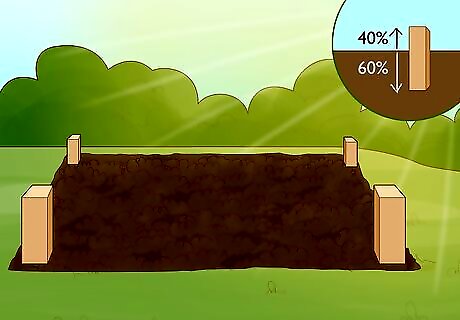
Place 4 wood stakes at the inner corners of the planter. You’ll need to use stakes to support the walls of the planter. At each of the 4 inside corners of the area you marked out, drive in a heavy wooden stake. Drive it in far enough so that about 60% of the stake is below ground, while the other 40% is exposed above ground. Use stakes that are long enough to reach the tops of the planter walls after you drive them in. If you’re building a long planter (e.g., longer than 4–6 feet (1.2–1.8 m), you may need to drive in stakes every 3 feet (0.91 m) for extra support.
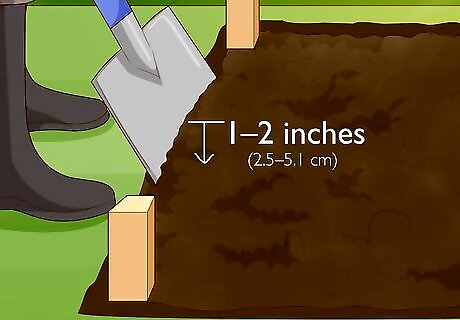
Dig a trench 1–2 inches (2.5–5.1 cm) deep along the edges of the planter. For extra stability, the walls of your planter should extend slightly below the surface of the ground. Use a spade or trenching shovel to dig down 1–2 inches (2.5–5.1 cm) along the edges where you plan to put the planks. To improve drainage, pour a little gravel into the bottom of the trench.
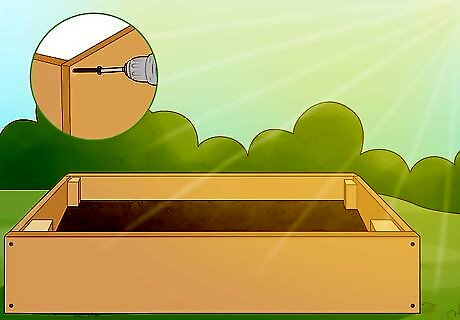
Attach the boards to the stakes with nails or screws. Set each board in place in the trench along the edge of the planter. Use galvanized nails or screws to attach them to the stakes. You might find it easier to pre-drill the planks if you are using screws. You can also create a frame by attaching the boards together with brackets, then simply set it in place around the outside of the bed. Then, fix it to the stakes for extra stability. If the boards you’re using aren’t wide enough to achieve the height you want, use taller stakes and build up the walls with 2 or more courses of boards. For example, use stakes that extend 24 inches (61 cm) above the ground, then built the sides of the frame with 2 rows of boards that are 12 inches (30 cm) wide.
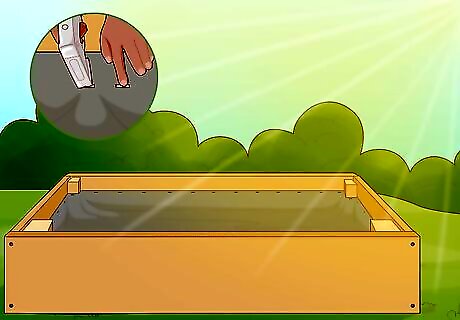
Line the planter with hardware cloth to keep out pests. If you’re worried about gophers, voles, or other burrowing pests, put a layer of ⁄2 or ⁄4 in (1.27 or 0.64 cm) hardware cloth on the bottom of the bed. You can attach it to the bottoms of the walls with a staple gun. The hardware cloth will keep out pests without preventing good drainage or rooting.
Filling and Planting the Bed
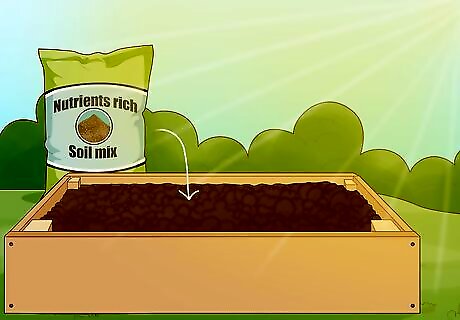
Fill the garden bed with a nutrient-rich soil mix. In order for your raised garden to flourish, provide it with plenty of high-quality soil. Offer a mixture of compost, topsoil, and manure or another organic fertilizer to keep your plants healthy and happy. The type of soil and fertilizer you need will depend on what you’re growing in your planter. Research the needs of the plants you’re interested in growing or talk to someone at your local garden center.
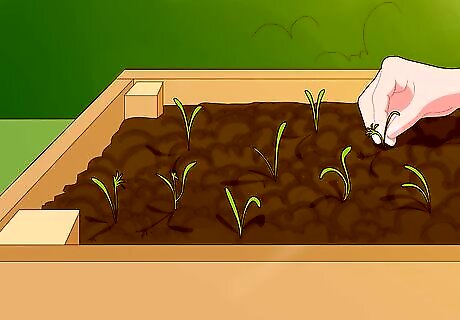
Plant flowers or vegetables in the garden bed. While many people use raised planters to grow vegetables, you can use them for anything. Fill up your raised bed with tomatoes or carrots, or use it to grow flowers or decorative grasses.Tip: Since your plants will be close together in the raised bed, make sure you choose good companion plants that won’t compete for nutrients. For example, carrots grow well together with cabbage or cucumbers. Plants that grow tall, such as tomatoes, cucumber vines, pole beans, or tall flowers like foxgloves, are good choices for raised beds. You may need to support them with stakes or trellises.
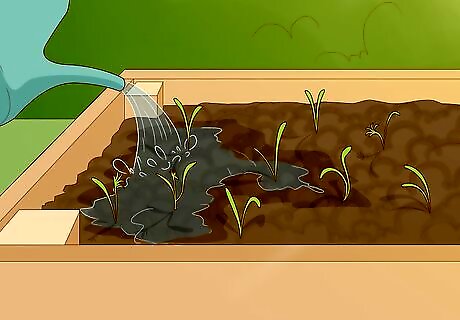
Water the plants frequently to prevent them from drying out. Raised garden beds will dry out more quickly than gardens planted directly in the ground. Keep a close eye on your raised planting bed and water the plants whenever you notice the soil drying out. For larger planting beds, it may be helpful to install an automated irrigation system to make sure the plants get all the water they need.
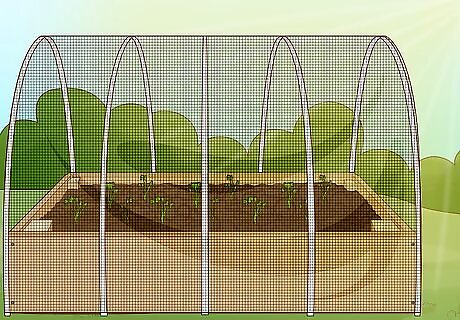
Add a cover to protect your plants from pests or the elements. If you want to cover your garden bed with netting to keep out insect pests, create a simple frame by bending lengths of PVC pipe into arches and mounting them over the planter. In cooler weather, create a mini-greenhouse by clipping a clear plastic cover to the PVC arches. Use flexible lengths of ⁄2 in (1.3 cm) pipe that are twice the width of your planter to make the arches. To mount the arches: Cut sections of stiff 1 in (2.5 cm) pipe to the same length as the height of the frame (e.g., 18 inches (46 cm)). Use clamps and screws to attach 2 sections of 1 in (2.5 cm) tube opposite each other on the inside of the frame anywhere you want to install an arch. For example, you might install these tubes at both ends and the middle of the planter frame. Insert 1 end of the ⁄2 in (1.3 cm) pipe into one of the short tube sections, bend it in the middle to create an arch, and insert the other end into the tube section on the opposite side of the planter.



















Comments
0 comment